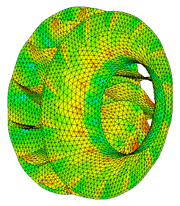Engineers
have always relied on mathematical tools
to calculate and verify the dimensions of
their work.
In mathematical terms, each physical phenomenon
is governed by differential equations.
Even though science has fixed the effective
form of such equations from the preindustrial
times, these equations are seldom
resolvable in a closed form and
very few analytical solutions exist today,
limited to cases whiche are geometrically
simple.
 The
consequence of such limits is the adoption
of specific semiempirical design
rules, validated for each application
sector based on the experience matured during
years of trials. Therefore the classical
approach is to use semplified mathematical
formulas to face even the most
complicated cases from an engineering point
of view. Although this method is still valid
and reliable it has it's limits. In order
to compensate the generality
of the hypothesis which is at the base of
the design rules and the peculiarity
of the structure to be verified, one proceeds
in a conservative way for security, knowing
that final tests which
are costly and time-consuming must be faced. The
consequence of such limits is the adoption
of specific semiempirical design
rules, validated for each application
sector based on the experience matured during
years of trials. Therefore the classical
approach is to use semplified mathematical
formulas to face even the most
complicated cases from an engineering point
of view. Although this method is still valid
and reliable it has it's limits. In order
to compensate the generality
of the hypothesis which is at the base of
the design rules and the peculiarity
of the structure to be verified, one proceeds
in a conservative way for security, knowing
that final tests which
are costly and time-consuming must be faced.
The availability of always higher performance
computers has pushed mathematicians and
software engineers to develop and render
usable the numerical analysis methods capable
of resolving the complex forms of differential
equations. The Finite Element method,
one of the most versatile and diffused methods,
discreting the continuous in a large number
but finite of geometrically simple elements,
allows for the derivation of equations suited
to be solved by computer; the calculation
of the largeness involved in the examined
physical phenomenon is therefore possible
virtually without limits to the geometric
complexity of the field.
Today the new technologies of modelling
to threedimentional CAD
together with the reliability of the finite
element codes, offer the possibility
to virtually model a component or a system
and to forsee the producibility and real
behaviour when working under static, dynamic,
thermic or fluid dynamic stress.
|
